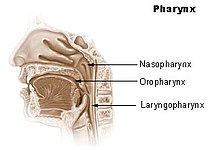General Anatomy/Digestive System
Mouth
[edit | edit source]
The mouth, also known as the buccal cavity or the oral cavity, is the orifice through which an animal takes in food and water, is the beginning of our digestive tracts.
Chewing is the first step in digestion:
- Lips
- Teeth (Incisors, Canines, Molars, Premolars etc.). The teeth chop the food into smaller pieces. The incisors cut the food. The canines grip and tear food. The premolars and molars grind the food.
- Tongue: tastes food the tongue crushes food against the hard palate. It moves food particles into a bolus that is pushed into the throat (pharynx).
- Jaw (Mandible)(Maxillary)
- Hard Palate/ Soft Palate
- Saliva (contains the enzymes salivary amylase, lysozyme, and lingual lipase). The salivary glands produce saliva into ducts in the mouth. Saliva has amylase which breaks down carbs and lipase which breaks lipids.
Most animals have a complete digestive system, with a mouth at one end and an anus at the other. Which end forms first in ontogeny is a criterion used to classify animals into protostome and deuterostome. In arthropods, they are external modified legs; in gnathostomata vertebrates they are internal.
Pharynx and oesophagus
[edit | edit source]
The throat (pharynx) moves food from the mouth to the esophagus. The soft palate and uvula close off the nasopharynx when swallowing. The epiglottis closes the larynx when swallowing.
The oesophagus is made of three different types of muscle in its external longitudinal layer:
- It's superior third is composed of voluntary striated muscle tissue,
- It's inferior third is composed of smooth muscle tissue,
- It's middle third is composed of a mixture of the aforementioned two.
The first function of the oesophagus is the 1-way transfer of food from the pharynx to the stomach. The next function of the oesophagus happens in the lower esophageal sphincter, which stops stomach contents from splashing back up.
Stomach
[edit | edit source]The stomach has four regions:
- Cardia or cardiac region
- Fundus
- Body
- Pylorus
It also has two sphincters;
- Cardiac sphincter
- Pyloric sphincter
The stomach empties the food from the oesophagus, churns and digests food, and stores food. It empties into the small intestine.
Small Intestine
[edit | edit source]It is the convoluted structure of digestive system that aids in digestion and maximum absorption takes place in intestine
Liver
[edit | edit source]- Produces bile by hepatocytes
Hepatocytes will then secrete the bile to the canaliculi of the liver. The flow of bile will continue to the right and left hepatic ducts which will meet at the common hepatic duct -> cystic duct -> gallbladder for storage. Then when bile is needed for digestion of fats, bile will empty from the gallbladder through the cystic duct -> common bile duct -> sphincter of oddi -> duodenum Bile helps in the digestion of fatty acids in food
Gall Bladder
[edit | edit source]- Stores bile which is made by the liver. Patients who undergo cholecystectomy (removal of the gallbladder) will have normal digestive function as bile drains through the common bile duct into the duodenum.
Pancreas
[edit | edit source]Located near the duodenum to empty pancreatic enzymes, and bicarbonate to neutralize stomach acid from the antrum.
Histology
Islets of Langerhans have alpha and beta cells that are responsible for maintaining the glucose concentration in the plasma. Alpha cells secrete glucagon and beta cells secrete insulin. These hormones are involved in the endocrine system.
Acinar cells will secrete enzymes that will help with digestion. These enzymes are released in an inactive form.
Large Intestine
[edit | edit source]- Cecum
- Verminform appendix
- Colon
Ascending, transverse, descending, and sigmoidal Also contains epiploic appendanges and taenia coli – bands of muscles Note the haustra – individual pouches formed by the taenia coli
- Rectum
- Anus
Anus
[edit | edit source]It is the last portion of digestive system. Disposes solid wastes.